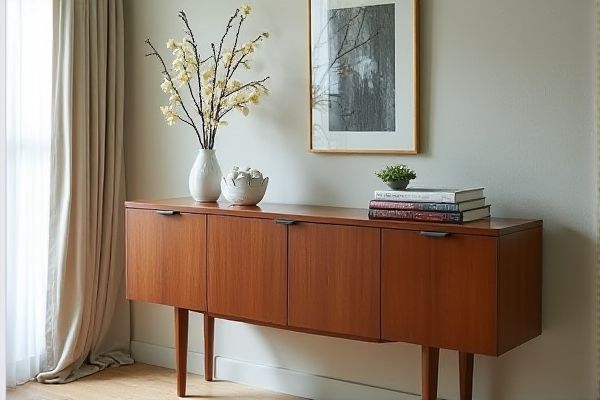
A drop-leaf console offers expandable surface space with hinged leaves that can be folded down for compactness, making it ideal for versatile living areas, while a fixed console provides a permanent, sturdy structure with a consistent footprint suited for stable decorative or storage purposes. Discover which console table best matches your space requirements and style preferences by reading the rest of the article.
Table of Comparison
| Feature | Drop-Leaf Console | Fixed Console |
|---|---|---|
| Design | Expandable with foldable sides | Solid, non-expandable structure |
| Space Efficiency | Compact when closed, expands when needed | Constant footprint, no flexibility |
| Functionality | Flexible use for limited spaces | Stable and sturdy for fixed layouts |
| Setup Complexity | Requires unfolding to use full surface | Ready to use immediately |
| Weight | Lighter due to moving parts | Generally heavier, stable |
| Maintenance | Hinges may require periodic checks | Low maintenance, solid construction |
| Price | Typically moderate due to mechanics | Varies, usually lower cost |
Introduction to Drop-Leaf and Fixed Consoles
Drop-leaf consoles feature hinged sections that can be extended or folded down to adjust the surface area, making them ideal for small spaces or versatile use. Fixed consoles have a permanent, non-adjustable surface that offers sturdy support and consistent design, often suited for areas where space is ample. Your choice depends on whether flexibility or stability is the priority in your living environment.
Design Differences: Drop-Leaf vs Fixed Console
Drop-leaf consoles feature hinged panels that can be extended or folded down, allowing flexible use of space and adaptable surface area. Fixed consoles have a permanent, solid top that offers consistent stability and a streamlined silhouette. Your choice between drop-leaf and fixed consoles depends on whether you prioritize versatility or a stable, uninterrupted design.
Space-Saving Solutions: Which Console Wins?
Drop-leaf consoles excel in space-saving solutions by offering flexible extension options that adapt to your room size, making them ideal for small or multi-use spaces. Fixed consoles provide a stable, permanent structure with consistent surface area but lack the versatility to expand or contract based on your needs. When prioritizing space efficiency and adaptability, drop-leaf consoles typically outperform fixed consoles by maximizing usable space without compromising functionality.
Versatility and Functionality Compared
A drop-leaf console offers enhanced versatility by allowing users to expand or reduce surface area based on need, making it ideal for small spaces or multifunctional rooms. Fixed consoles provide consistent stability and durability with a solid, immovable surface suitable for heavy items or permanent setups. While drop-leaf consoles emphasize adaptable functionality, fixed consoles prioritize robustness and straightforward use.
Aesthetic Appeal and Style Options
Drop-leaf consoles offer versatile aesthetic appeal with their adjustable surfaces, allowing for a dynamic look that combines functionality and elegance in small spaces. Fixed consoles provide a stable, streamlined design often favored for consistent style themes and a clean, timeless appearance. Both options come in various materials and finishes, catering to diverse interior design preferences from modern minimalist to classic traditional.
Durability and Maintenance Considerations
Drop-leaf consoles feature hinges that require regular inspection and lubrication to maintain smooth operation, potentially leading to faster wear compared to fixed consoles. Fixed consoles, constructed with solid joints, offer greater durability due to their stable, non-moving parts, reducing maintenance needs over time. Choosing fixed consoles minimizes the risk of mechanical failures and extends lifespan, while drop-leaf designs demand more attentive upkeep to ensure longevity.
Cost Analysis: Drop-Leaf Console vs Fixed Console
Drop-leaf consoles typically offer cost savings due to their space-saving design and flexible functionality, reducing the need for additional furniture in smaller areas. Fixed consoles often have higher upfront costs because of their solid, permanent structure, though they may provide better durability and stability over time. Your choice depends on budget priorities: drop-leaf consoles maximize versatility at a lower price, while fixed consoles represent a longer-term investment with consistent performance.
Ideal Use Cases and Room Suitability
Drop-leaf consoles are ideal for smaller spaces and multifunctional rooms, offering flexibility by allowing you to extend the surface when needed and fold it down to save space. Fixed consoles provide a sturdy and permanent surface suited for larger rooms or areas where consistent table space is required. Your choice depends on whether you prioritize versatility for compact living areas or prefer a stable setup for spacious environments.
Pros and Cons: Quick Comparison
A drop-leaf console offers versatility with foldable sides that save space and adapt to varying needs, making it ideal for smaller rooms or multifunctional areas. Fixed consoles provide sturdy construction and consistent surface area, ensuring durability and a stable platform for decor or electronics. Your choice depends on balancing space efficiency with the need for a permanent, robust setup.
How to Choose Between Drop-Leaf and Fixed Consoles
Choosing between drop-leaf and fixed consoles depends on the available space and your need for flexibility. Drop-leaf consoles offer adjustable surface area, ideal for smaller rooms or adaptable setups, while fixed consoles provide stability and a consistent workspace for permanent use. Consider your lifestyle and how you plan to use Your console to determine the best option.
 homyna.com
homyna.com